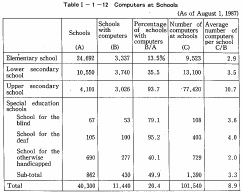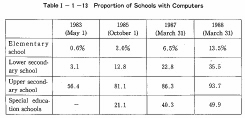| Home > Policy > White Paper, Notice, Announcement > White Paper > JAPANESE GOVERNMENT POLICIES IN EDUCATION,SCIENCE AND CULTURE 1989 > PART |
||
The growth of income level of Japanese people after World War II has been remarkable. They are much better off economically than before, and can afford to lead an intellectually and culturally high quality of life. Also the progress in science and technology and economic development have brought forth major changes in the industrial and employment structure and promoted urbanization and information oriented society, thus bringing about remarkable changes in daily life at working places and at home. Moreover, the spread of the five working days a week, the introduction of labor-saving devices at home, and the prolongation of life expectancy have increased leisure time, and accordingly, brought about upgraded quality and individualized style of life.
Adapting properly to the progress of science and technology, an affluent and upgraded quality of life and the advancement of aging society, and cultivating from the stage of elementary and secondary education the basic ability to continue learning effectively in a lifelong learning society are extremely important issues confronting us.

International exchange of persons, materials and information has been increasingly active, promoted by the remarkable development of science and technology, and particularly improvement in transportation and communication. The area where exchange is taking place is not limited to the economic sector. Nations are deepening their interdependence in the areas of education, science, culture and sports as well. Deepening international interdependence, on the other hand, is accompanied by the intensification of international conflicts in various respects.
Learning history, culture and customs of other countries and understanding each other are important in the international society. For our nation to assume responsibilities proportionate to its standing in the international community, every citizen should be required to be independent in their awareness and behavior.
In practical terms, our people are called upon to understand multiple cultural traditions abroad and embody the ability to communicate with foreigners along with deep understanding of our own tradition and culture. The most important issue thus lies in how to cultivate such abilitiy from the stage of elementary and secondary education.

The development of advanced information technology is remarkable. Computers and other means of new information technology are coming into our daily life with amazing speed. They provide richness and convenience to our life, but they also exert some negative influences.
In school education also, the promotion of education that can respond to information oriented society is a big pressing issue. School education must cultivate the ability to independently use information and handle information for social and professional purposes and thus appreciate the importance of information and its impact on society and people.
The advancement of information oriented society, however, has caused massive growth in the quantity of information flowing in one direction. Along with it, will be excessive dependence on information and the decrease of first hand experiences because of contact with nature replaced by indirect experiences-via media. Education in response to information oriented society, therefore, ought to be promoted,
keeping these negative aspects sufficiently in mind.


| Back to Top | MEXT HOME |